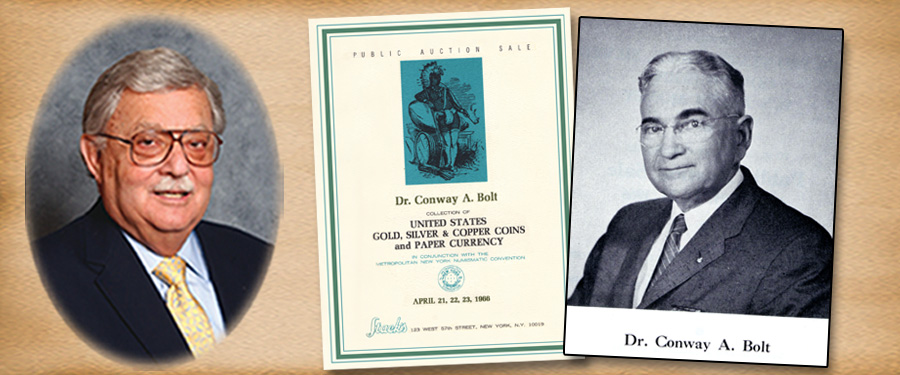
For Part 4 of my series on Dr. Conway A. Bolt, I will begin to focus on some different areas of his collection, including his exciting cabinet of pioneer and territorial gold coins of America and also his collection of early bank notes from before federal paper money was issued.
Both of these series were collected as a result of Dr. Bolt’s interest in the histories of the companies that issued them, their importance to the advancement of commerce and their contribution to our national heritage. As the good doctor lived in the Mid-Atlantic States, the issues by Bechtler in both Carolina and Georgia were appealing to him for the part they played in history of that area. He visited the museums where Bechtler coins were shown, and met the curators who explained to him the development of the Bechtler coinage, made from the gold found in the Carolina and Georgia areas. Some of the history of the banking and commerce of these southern states could be told by the gold coins, (and of course the bank notes) which were issued in the area.
Also adding to the information he gained was his great friendship with George O. Walton, (see earlier in this column for more information on Walton) who was a bank examiner and also worked for the Federal Government in the mid-Atlantic area. Dr. Bolt learned a lot from George and gained from the knowledge the latter gentleman had gained in his working and collecting. Mr. Walton collected, bought and sold coins and currency to collectors as he passed from town to town (over the hills and valleys as he used to tell it), and gathered together gold coins, antiques, and anything that was of interest to him. When he visited Dr. Bolt, they shared the stories each had heard, traded coins and currency and became profoundly interested in the monetary history of this pre-Civil War period.
First I will review the extent of George Walton’s and Dr. Bolt’s Bechtler coinage. While going through the hoard that George O. Walton left, Norman Stack and I discovered some 27 different examples of Carolina and Bechtler coinage. In the Walton catalog we wrote a list and description of each variety and we gave them "S" numbers for "Stack’s" as this was the first time all were listed and described. We consulted with Dr. Bolt and he reported that the varieties we found of the Bechtler coinage, as of the time he worked with Walton on the collecting this issue, were all that were known at that time.
A review of the Bolt Collection showed us among his 29 specimens, he lacked two that Walton had but had one that Walton did not have. So the S -27 became a new variety which was an A.BECHTLER 1.00 GOLD, 27 G. 21 C., which had a unique reeded edge, instead of a plain edge as on the Walton coins. It was a "find" for Norman and me and became listed as such. Working on two important collections of a series gave us the opportunity to examine all the coins carefully and discover the varieties. It is extra exciting for a cataloger to discover something new!
Dr. Bolt had other pioneer coins within his collection and I will continue to describe them in the next part of my story of this amazing collection. I will also tell of the U.S. patterns he assembled and the federal paper money he possessed. This story has been a reminder of what a fine collection this was, the fun I had working on it and the great knowledge I gained. This was true whenever I and others had the enviable task of producing an informative and attractive catalog.
More to come in Part 5 of the Dr. Conway A. Bolt Collection.





